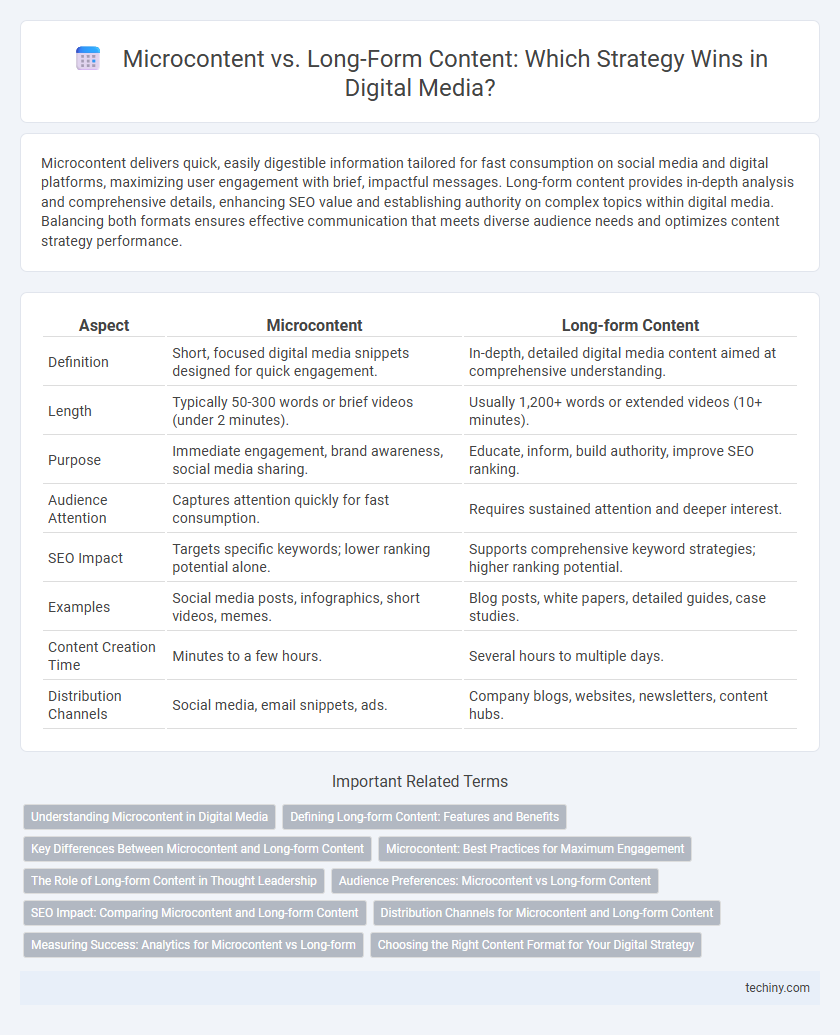Microcontent delivers quick, easily digestible information tailored for fast consumption on social media and digital platforms, maximizing user engagement with brief, impactful messages. Long-form content provides in-depth analysis and comprehensive details, enhancing SEO value and establishing authority on complex topics within digital media. Balancing both formats ensures effective communication that meets diverse audience needs and optimizes content strategy performance.
Table of Comparison
| Aspect | Microcontent | Long-form Content |
|---|---|---|
| Definition | Short, focused digital media snippets designed for quick engagement. | In-depth, detailed digital media content aimed at comprehensive understanding. |
| Length | Typically 50-300 words or brief videos (under 2 minutes). | Usually 1,200+ words or extended videos (10+ minutes). |
| Purpose | Immediate engagement, brand awareness, social media sharing. | Educate, inform, build authority, improve SEO ranking. |
| Audience Attention | Captures attention quickly for fast consumption. | Requires sustained attention and deeper interest. |
| SEO Impact | Targets specific keywords; lower ranking potential alone. | Supports comprehensive keyword strategies; higher ranking potential. |
| Examples | Social media posts, infographics, short videos, memes. | Blog posts, white papers, detailed guides, case studies. |
| Content Creation Time | Minutes to a few hours. | Several hours to multiple days. |
| Distribution Channels | Social media, email snippets, ads. | Company blogs, websites, newsletters, content hubs. |
Understanding Microcontent in Digital Media
Microcontent in digital media refers to brief, easily digestible units of information such as social media posts, headlines, and snippets designed to capture attention quickly and convey core messages efficiently. It serves as a crucial tool for engaging audiences in fast-paced online environments where users prefer concise, actionable content over lengthy narratives. Understanding microcontent enables digital marketers to enhance content strategy by leveraging targeted messaging and maximizing user interaction across multiple platforms.
Defining Long-form Content: Features and Benefits
Long-form content typically exceeds 1,200 words, offering in-depth analysis, comprehensive insights, and detailed information that engages readers for extended periods. It enhances SEO by targeting multiple keywords and providing valuable, authoritative content that boosts domain credibility. The benefits include higher search engine rankings, increased user engagement, and greater potential for social sharing and backlinks.
Key Differences Between Microcontent and Long-form Content
Microcontent consists of brief, easily digestible pieces such as social media posts, infographics, or short videos, designed for quick consumption and high engagement. Long-form content typically exceeds 1,000 words and includes detailed articles, comprehensive guides, or in-depth reports aimed at thorough information delivery and SEO value. The key differences lie in length, depth of information, user engagement, and purpose, with microcontent prioritizing immediacy and shareability, while long-form content focuses on authority and detailed user education.
Microcontent: Best Practices for Maximum Engagement
Effective microcontent in digital media leverages concise messaging and captivating visuals optimized for rapid consumption on social platforms, enhancing user engagement and shareability. Utilizing clear calls-to-action, strategic hashtags, and targeted keywords amplifies visibility and interaction rates across channels like Instagram, TikTok, and Twitter. Frequent A/B testing of headlines, formats, and posting times ensures microcontent resonates with audience preferences, maximizing reach and retention.
The Role of Long-form Content in Thought Leadership
Long-form content establishes thought leadership by providing in-depth analysis, comprehensive insights, and extensive research that short microcontent cannot match. It builds trust and authority in digital media by offering valuable information that engages audiences for longer periods and encourages sharing and backlinks, boosting SEO performance. Brands leveraging long-form content position themselves as industry experts, driving higher engagement and fostering deeper connections with their target audience.
Audience Preferences: Microcontent vs Long-form Content
Audience preferences in digital media reveal a strong inclination towards microcontent for quick consumption and immediate engagement, especially on social platforms like Instagram and TikTok. Long-form content, favored in niches like educational blogs and in-depth tutorials, attracts users seeking comprehensive information and detailed insights. Understanding these preferences allows marketers to tailor content strategies that maximize reach and user retention by balancing brevity with depth.
SEO Impact: Comparing Microcontent and Long-form Content
Microcontent, such as social media posts and infographics, enhances SEO by driving quick user engagement and increasing click-through rates through concise, targeted messaging. Long-form content, including detailed articles and comprehensive guides, improves SEO by offering in-depth information that boosts dwell time, backlinks, and keyword relevance. Combining both strategies optimizes digital media campaigns by balancing immediate user interaction with sustained search engine authority.
Distribution Channels for Microcontent and Long-form Content
Microcontent thrives on social media platforms, mobile apps, and email newsletters where short, engaging snippets capture user attention quickly and encourage sharing across networks. Long-form content is primarily distributed via blogs, websites, and professional platforms like LinkedIn, enabling in-depth exploration of topics and better SEO performance. Choosing the right channel enhances content effectiveness by aligning format with user consumption habits and platform strengths.
Measuring Success: Analytics for Microcontent vs Long-form
Measuring success for microcontent involves analyzing real-time engagement metrics such as click-through rates, social shares, and time spent on content, which provide immediate feedback on audience interaction. Long-form content success is often evaluated through in-depth analytics like average session duration, scroll depth, conversion rates, and search engine rankings, reflecting sustained user interest and SEO impact. Comparing these metrics helps digital marketers optimize content strategies by balancing quick engagement from microcontent with the comprehensive value and authority established by long-form content.
Choosing the Right Content Format for Your Digital Strategy
Microcontent offers concise, easily digestible information optimized for quick engagement on platforms like social media and mobile apps, making it ideal for capturing audience attention in high-traffic environments. Long-form content provides in-depth analysis, comprehensive storytelling, and detailed insights suitable for building authority, improving SEO, and fostering deeper audience relationships on blogs and websites. Selecting the right content format depends on your target audience behavior, marketing goals, and distribution channels to maximize reach and impact within your digital strategy.
Microcontent vs Long-form Content Infographic

 techiny.com
techiny.com